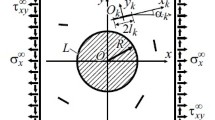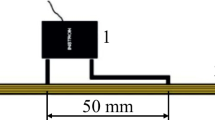Conclusions
A numerical analysis of the stress field at the tip of a crack showed high localization, increasing with increase of anisotropy and normal and shear stresses at the crack tip, which can cause various types of fracture. The use of the J-integral for estimates of the flow of elastic energy to the crack tip, simulated by a greatly elongated elliptical notch, is apparently possible in approximate calculations, taking into account localization of the zone of nonlinear behavior of the material. A scheme of estimating the crack resistance of a fibrous material with brittle components, taking into account the contribution of various forms of microfracture to energy dissipation, is proposed. The calculated value of G* differs from the experimental data by about 20%, which, taking into account the simplicity of the calculation method, can be considered satisfactory.
Similar content being viewed by others

Literature cited
J. Rhys, “Mathematical methods in fracture mechanics,” in: Fracture [Russian translation], Vol. 2, Moscow (1975), pp. 204–335.
S. G. Lekhnitskii, Theory of Elasticity of an Anisotropie Body [in Russian], 2nd ed., Moscow (1977).
A. N. Polilov, “Arrest of a crack by an interface,” Izv. Akad. Nauk SSSR, Mekh. Tverd. Tela, No. 1, 68–72 (1974).
J. Cook and J. E. Gordon, “A mechanism for the control of crack propagation in allbrittle systems,” Proc. R. Soc. Ser. A,282, No. 1391, 508–520 (1964).
M. R. Piggott, “Theoretical estimation of fracture toughness of fibrous composites,” J. Mater. Sci.,9, No. 8, 669–675 (1970).
Z. Hashin and A. Rotem, “A fatigue failure criterion for fiber reinforced materials,” J. Comp. Mater.,7, 448–464 (1973).
A. Kelly, Strong Solids, Oxford Univ. Press (1973).
A. G. Atkins, “Intermittent bonding for high toughness/high strength composites,” J. Mater. Sci.,10, No. 5, 819–832 (1975).
Author information
Authors and Affiliations
Additional information
Translated from Mekhanika Kompozitnykh Materialov, No. 4, pp. 615–619, July–August, 1981.
The author thanks S. T. Mileiko for formulating the problem, advice, and discussion of the work.
Rights and permissions
About this article
Cite this article
Kiiko, V.M. Modeling of fracture of fibrous composites with brittle components. Mech Compos Mater 17, 415–419 (1982). https://doi.org/10.1007/BF00605907
Received:
Issue Date:
DOI: https://doi.org/10.1007/BF00605907



